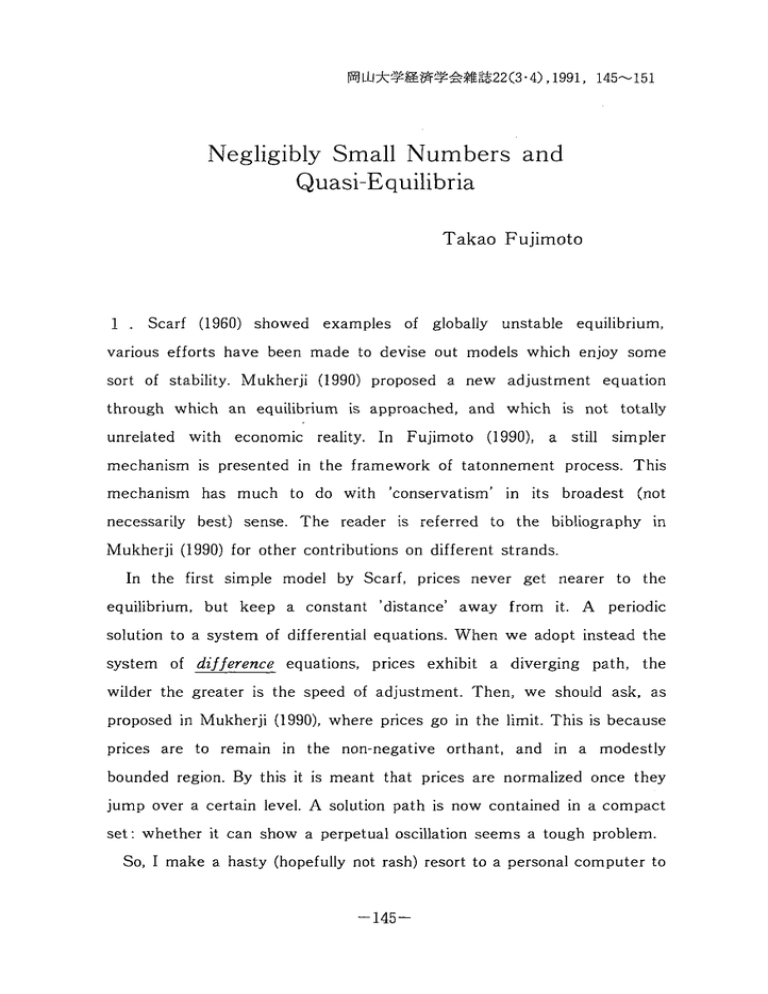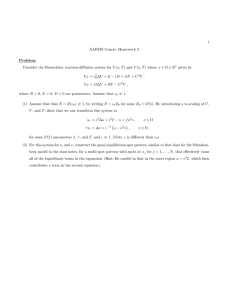Negligibly Small Numbers and Quasi
advertisement

Negligibly Small Numbers and
Quasi-Equilibria
Takao Fujimoto
1 . Scarf (1960) showed examples of globally unstable equilibrium,
various efforts have been made to devise out models which enjoy some
sort of stability. Mukherji (1990) proposed a new adjustment equation
through which an equilibrium is approached, and which is not totally
unrelated with economic reality. In Fujimoto (1990), a still simpler
mechanism is presented in the framework of tatonnement process. This
mechanism has much to do with 'conservatism' in its broadest (not
necessarily best) sense. The reader is referred to the bibliography
In
Mukherji (1990) for other contributions on different strands.
In the first simple model by Scarf, prices never get nearer to the
equilibrium, but keep a constant 'distance' away from it. A periodic
solution to a system of differential equations. When we adopt instead the
system of dijjerence equations, prices exhibit a diverging path, the
wilder the greater is the speed of adjustment. Then, we should ask, as
proposed in Mukherji (1990), where prices go in the limit. This is because
prices are to remain in the non-negative orthant, and in a modestly
bounded region. By this it is meant that prices are normalized once they
jump over a certain level. A solution path is now contained in a compact
set: whether it can show a perpetual oscillation seems a tough problem.
So, I make a hasty (hopefully not rash) resort to a personal computer to
-145-
522
handle this problem. This note is to report the result.
2. Let us consider the first simple model in Scarf (1960). There are
three consumers in our exchange economy. Three types of commodities
are existent. Before markets are opened, consumer i has one unit of
commodity i respectively, where i = 1, 2, and 3. Consumer i has a utility
function.
The subscript i + 1 should be understood in terms of modulus when it
goes beyond 3. By the usual procedure, one obtains the following excess
demand functions.
el (PJ, Pz, P3)
P3/(P3
ez (PJ, h
Pl/(Pl
P3)
=
e3 (Ph h, P3)
pz /(Ps
+
+
+
Pl)
pz /(Pl
pz)
P3/(PZ
P3) - PJ /(P3
+ Pz),
+ N,
+ Pl).
Here Pi is the price of commodity i.
As is seen immediately,the equilibrium price vector is k(l, 1, 1) with k
being a positive scalar. When we employ the ordinary version of
adjustment eq uation
dPi /
dt
=
ei (PJ, h
P3)
jor
it is not difficult to verify L P,'
=
i = 1, 2, and 3,
constant on a solution path,using the
Walras Law. Moreover, Scarf showed that Pi pz P3 is also constant on an
orbit. These two properties are enough to prove global instability.
Now we shift to
the
adjustment system comprising difference
equations:
Pi (t
+
1)
=
max (0, Pi (t)
+
a'ei (PJ, h
Ps) jor i
=
1, 2, and 3,
where a denotes the speed of adjustment assumed to be common among
the markets. The above system considers the non-negative constraint,
-146-
Negligibly Small Numbers and Quasi-Equilibria
523
while setting no upper bound on prices. When we execute a program
which describes the system, it terminates by zero division because of
finite memory of a computer. If one examines the situation at the
termination, it will be found that the economy is certainly not
III
the
equilibrium. For example, when the initial price vector is (2.2, 2.2, 1), the
speed of adjustment a
=
I, and the
relevant variables have six
significant digits, then after 50 iterations the process halts: the final state
is P
=
(5.1, 0, 0). As for the last but one state, we have P = (5.1, 0,
0.30) with the excess demand (0.056, 0, - 0.94).
Can this penultimate state be called an equilibrium ? The excess
demand for commodity 1 may be negligible, while P3 seems negligible
though e3 is negative. Surely, whether we can neglect some small
numbers depends on the choice of units of measurement. Let us suppose
a suitable choice has been done, and numbers are after all small, i. e.,
negligible.
3 . It should be better understood if one thinks of markets where
minimum prices are specified below which any transaction is prohibited.
We regard such regulatory lower bounds also as
'negligibly small
numbers'. Now denote by NS a negligibly small number, and let us set
out the rules of adjustment. (We assume NS is the same among markets
for simplicity.)
(l)
If Pi (t
+
1) becomes less than or equal to NS while Pi (t) is
greater than NS, Pi (t
(2)
If both Pi (t
+
+
1) is readjusted to be NS.
1) and Pi (t) are not more than NS, it
IS
set to
zero, i.e., declared 'free'.
(3)
If anyone of prices becomes greater than MAX (a positive
-147-
524
number), normalization of prices
IS
performed so that the maximum
price among three is readjusted to be MAX.
One more concept of quasi-equilibrium. A state is quasi-equilibrium if the
following conditions are met.
(i)
Each excess demand is not more than NS.
(il)
If an excess demand
IS
negative, the corresponding pnce should
not be more than NS.
A computer program realizing the above adjustment process is given m
Appendix. In the program, NS
0.01 and MAX
=
3, and whenever a
price hits into the region of small numbers, the program examines
whether the current state is quasi-equilibrium or not, and if the answer is
in the affirmative, it halts.
There are three quasi-equilibria: (3, 0, NS), (NS, 3, 0), and (0, NS, 3).
(We identify price vectors on a ray from the origin.) Surprisingly or not,
given any (?) initial point the process can reach a quasi-equilibrium. The
greater is the speed of adjustment, the quicker it ends up happily. The
system is not structually stable,though. A slight change in the speed of
adjustment brings the economy to a totally different quasi-equilibrium.
4 . Here are some technical remarks. We could assume different small
numbers for prices and excess demands separately. Th.e result, however,
remains essentially the same. The program is written in Turbo PASCAL
version 3.01, and can run in the integrated environment of version 4 or 5
also with a slight modification. In the later versions, one can add some
graphics routines so that it is possible to visualize the process colourfully.
The author has prepared those programs with graphics both in Turbo
PASCAL and Turbo BASIC, which are available on request.
-148-
Negligibly Small Numbers and Quasi-Equilibria
5. Now a final remark about two awkward points
In
525
our quasi-equilibri-
um. Suppose we are in the quasi-equilibrium (3, 0, NS). (1) The second
consumer,
with
endowment
declared
to
be
free,
donates
all
his
commodity to the first consumer ! (2) Since the excess demand for
commodity 1 is positive (though negligible), some degree of altruism is
also required here.
Together with the author's note (1990), we can say 'conservatism'
enhances stability and brings forth a more equitable outcome. Maybe, too
much.
References
( 1) T. Fujimoto, "Stabilizing Scarf's Unstable Examples," Okayama Economic Review,
Vol. 22 (1990) pp.67-7l.
(2) A. Mukherji, "On Tatonnement Process," mimeo at the Institute of Socio-Economic Planning, Tsukuba University (1990).
(3) H. Scarf, "Some Examples of Global Instability of Competitive Equilibrium,"
International Economic Review,Vol. I (1960), pp. 157-172.
-149-
526
Appendix
program NEGS;
{ooo for TP on 'BO-07-14(Sat.) :rev.7-17(Tuc.) :Tf ooo}
(********************************************************************)
(000
(000
An Example of Globally Unstable Competitive Equilibrium
due to H.Scarf(I.E.R. ,Vol.I,IB60J: PGM."ScarfS"
oooJ
000)
(********************************************************************)
label
CY;
canst
NS:real·O.OI;
(0
a negligibly small number
0)
var
A
real;
PITI,PZTI,P3TI: real;
PITO,PZTO,P3TO: real;
speed of adjustment
past prices
current prices
values of Excess D.
flags
iteration count
(0
(0
(0
(0
(0
(0
vexcl,vexc2,vexc3: real;
CZI,CZ2,CZ3
integer;
IT
: integer;
function EXCI(PI,PZ,P3:real):real;
begin
EXCI:· «P3)/(P3+PI»-P2/(PI+PZ)
end;
function EXC2(PI,PZ,P3:real):real;
begin
EXC2:· «PI)/(PI+PZ»-P3/(P2+P3)
end;
function EXC3(PI,P2,P3:real):real;
begin
EXC3:= «P2)/(PZ+P3»-PI/(P3+PIJ
end;
(***
oj
oj
0)
0)
0)
0)
Excess Demand Functions
(0
EXCI 0)
(0
EXCZ 0)
(0
EXe3 0)
procedure CHECKQE; (0 check whether the state is in Quasi-Equilibrium 0)
begin
writeln(#7) ;
0)
(0 a bell sound when examining
i f (vexcl>NS) or (vexc2>NS) or (vexc3>NS) then exit;(o No. 0)
if (vexcl<O) and (PITO>NS) then exit;
if (vexc2<O) and (P2TO>NS) then exit;
if (vexc3<O) and (P3TO>NS) then exit;
begin
writeln;
writeln(' . 0 0 Yes,in Quasi-Equilibrium
') ;
, ,NS: 7: 5) ;
writeln('
value of a small number
writeln('
halt;
end;
end;
000
the speed of adjustment
',A:7:5) ;
procedure DISPE;(o display the values of Excess Demand functions 0)
begin
writeln( ,
PI ·',PITO,';
Excl =', vexcl) ;
writeln( ,
PZ .',PZTO,';
Excl =', vexcZ) ;
wri teln('
P3 . ' ,P3TO,';
Excl =', vexc3) ;
-150-
Negligibly Small Numbers and Quasi-Equilibria
527
end;
begin (******* MAIN *******)
clrscr:
writeln(' ••• Press Shift key to have a temporary stop. To restart ***');
writeln(· ••• press any other key. If you hit "q",then quitting.
• ••. );
write(· ••• Key in the speed of adjustment. (Default A=I.O). A = ');
A:=O.O;
Readln(A) ;
if A=O.O then A:=I.O:
(.
.)
---------------------------------------------------------------
(.
.)
(.
Ini tial Values
.)
(.
.)
PITI:=2.2; P2TI:=2.2; P3TI:=I;
---------------------------------------------------------------
(.
IT:=O;
(.==
CY:
.)
Iteration count ==*)
(. label for looping cycle .)
IT:=IT+I;
PITO:= PITI + A*EXCI(PITI.P2TI,P3TI);
P2TO:= P2TI + A*EXC2(PITI.P2TI,P3TI);
P3TO:= P3TI + A*EXC3(PITI.P2TI,P3TI);
if (PITO>3)
if PITO>3
if P2TO>3
if P3TO>3
end;
(. adjusting prices *)
(. normalization
or (P2TO>3) or (P3TO>O) then begin
then begin PITO:=3; P2TO:=P2TO'3/PITO; P3TO:=P3TO*3/PITO
then begin P2TO:=3; PITO:=PITO'3/P2TO; P3TO:=P3TO*3/P2TO
then begin P3TO:=3; PITO:=PITO'3/P3TO; P2TO:=P2TO*3/P3TO
*)
end;
end;
end;
if (PITO<=NS) then PITO:=NS;
if (PITO<=NS) and (PITI<=NS) then PITO:=O;
if (PITO<=NS) and
if (P2TO<=NS) then
if (P2TO<=NS) and
if (P2TO<=NS) and
if (P3TO<=NS) then
if (P3TO<=NS) and
if (P3TO<=NS) and
(PITI>NS)
P2TO:=NS;
(P2TI<=NS)
(P2TI>NS)
P3TO:=NS;
(P3TI<=NS)
(P3TI>NS)
then CZI:=1 else CZI:=O; (* if newly entered
then P2TO:=O;
then CZ2:=1 else CZ2;=O;
then P3TO:=O;
then CZ3:=1 else CZ3;=O;
vexcl:=EXCI(PITO,P2TO.P3TO) ;
vexc2:=EXC2(PITO,P2TO.P3TO) ;
vexc3:=EXC3(PITO.P2TO,P3TO);
wr i teln (IT) ;
DISPE;
if (CZI=I)
or (CZ2=1) or (CZ3=1) then CHECKQE; (* if flaga are ON ... *)
PITI:=PITO; P2TI;=P2TO; P3TI;=P3TO;
GOTO CY;
end.
(* prep for the next round.
(* back to the iteration
-151-


